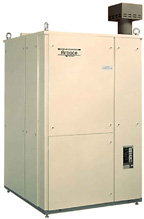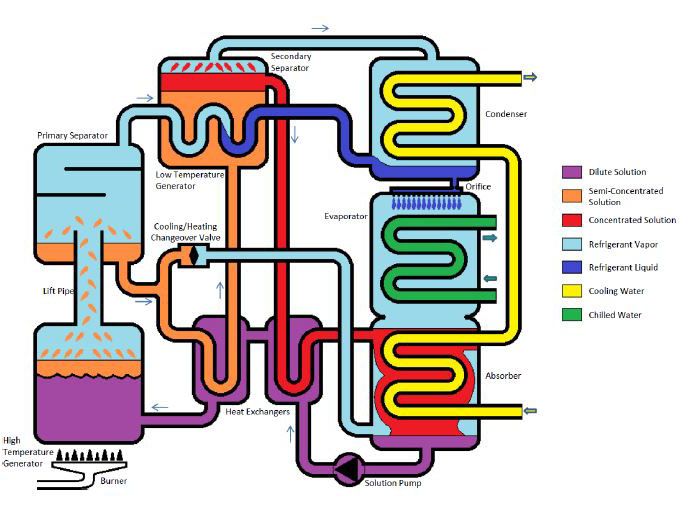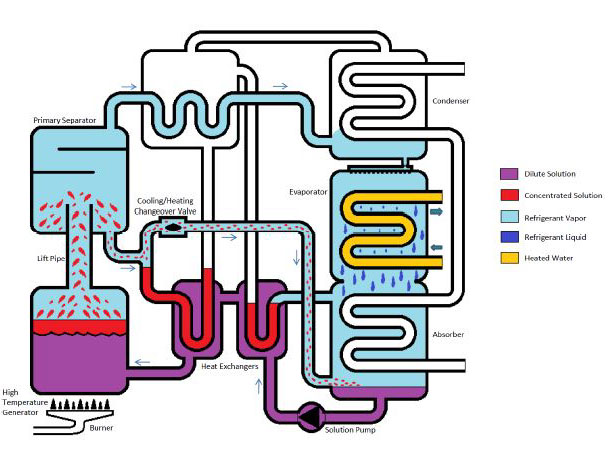

Gas Fired Double-Effect Chiller-Heaters
CH-K Series: 30, 40, 50, 60, 80, 100 RT Cooling with Standard Heating Capacities
How They Work
Yazaki K-Series gas-fired DOUBLE-EFFECT chiller-heaters, with cooling capacities of 30 to 100 tons of refrigeration, are designed for commercial applications where chilled and hot water are used in a central air conditioning system. The condenser is water-cooled, and during cooling operation heat is rejected through a cooling tower or a ground loop.
- Absorption Principle:
- Yazaki absorption chiller-heaters use a solution of lithium bromide and water under a very low pressure as the working fluid. Water is the refrigerant and lithium bromide is the absorbent. The double-effect absorption cycle has two generators, one directly heated by the gas-fired burner and the other heated by hot refrigerant vapor. Refrigerant, liberated by heat from the solution, produces a refrigerating effect in the evaporator when cooling water is circulated through the condenser and absorber.
- Cooling Cycle:

- High Temperature Generator
The gas burner heats dilute lithium bromide solution in the high temperature generator and the boiling process drives the refrigerant vapor along with droplets of semi-concentrated solution up into the primary separator. The semi-concentrated solution is pre-cooled through a heat exchanger before flowing into the low temperature generator.
- Low Temperature Generator
Hot refrigerant vapor from the primary separator heats the semi-concentrated solution in the low temperature generator. Refrigerant vapor released from this solution flows to the condenser while concentrated solution is pre-cooled through a heat exchanger before flowing into the absorber.
- Condenser
Refrigerant vapor is condensed on the surface of the condenser coil and latent heat removed by the cooling water is rejected to a cooling tower, ground loop, or other heat rejection device. Refrigerant liquid accumulates in the condenser sump and then passes through an orifice into the evaporator.
- Evaporator
Pressure in the evaporator is substantially lower than the pressure in the condenser due to the influence of the absorber. As the refrigerant liquid flows into the evaporator, it boils on the surface of the chilled/hot water coil. Heat, equivalent to the latent heat of the refrigerant, is removed from the recirculating water which is chilled to 44.6°F (7°C) at standard conditions. The refrigerant vapor flows to the absorber.
- Absorber
A low pressure in the absorber is maintained by the affinity of the concentrated lithium bromide solution from the separator with the refrigerant vapor formed in the evaporator. The refrigerant vapor is absorbed by the concentrated lithium bromide solution as it flows across the surface of the absorber coil. Heat of condensation and dilution are removed by the cooling water. The dilute lithium bromide solution is pre-heated through the heat exchangers before returning to the generator.
- Heating Cycle:

- High Temperature Generator
The solution boils in the high temperature generator in a manner identical to the cooling cycle. Refrigerant vapor and concentrated solution rise into the primary separator.
- Evaporator
Hot refrigerant vapor and droplets of concentrated solution flow through an open cooling/heating changeover valve into the evaporator/absorber section. Some refrigerant vapor flows into the evaporator/absorber section via the condenser. Since the pressures in the evaporator and the condenser sections are similar and there is no cooling water flow, the hot refrigerant vapor condenses on the surface of the chilled/hot water coil. Heat equivalent to the latent heat of the refrigerant is transferred to the recirculating water which is heated to 131°F (55°C) at standard conditions.
- Absorber
Liquid refrigerant drips off the chilled/hot water coil into the sump to mix with the concentrated lithium bromide solution to form a dilute solution and is returned to the generator where the cycle is repeated.